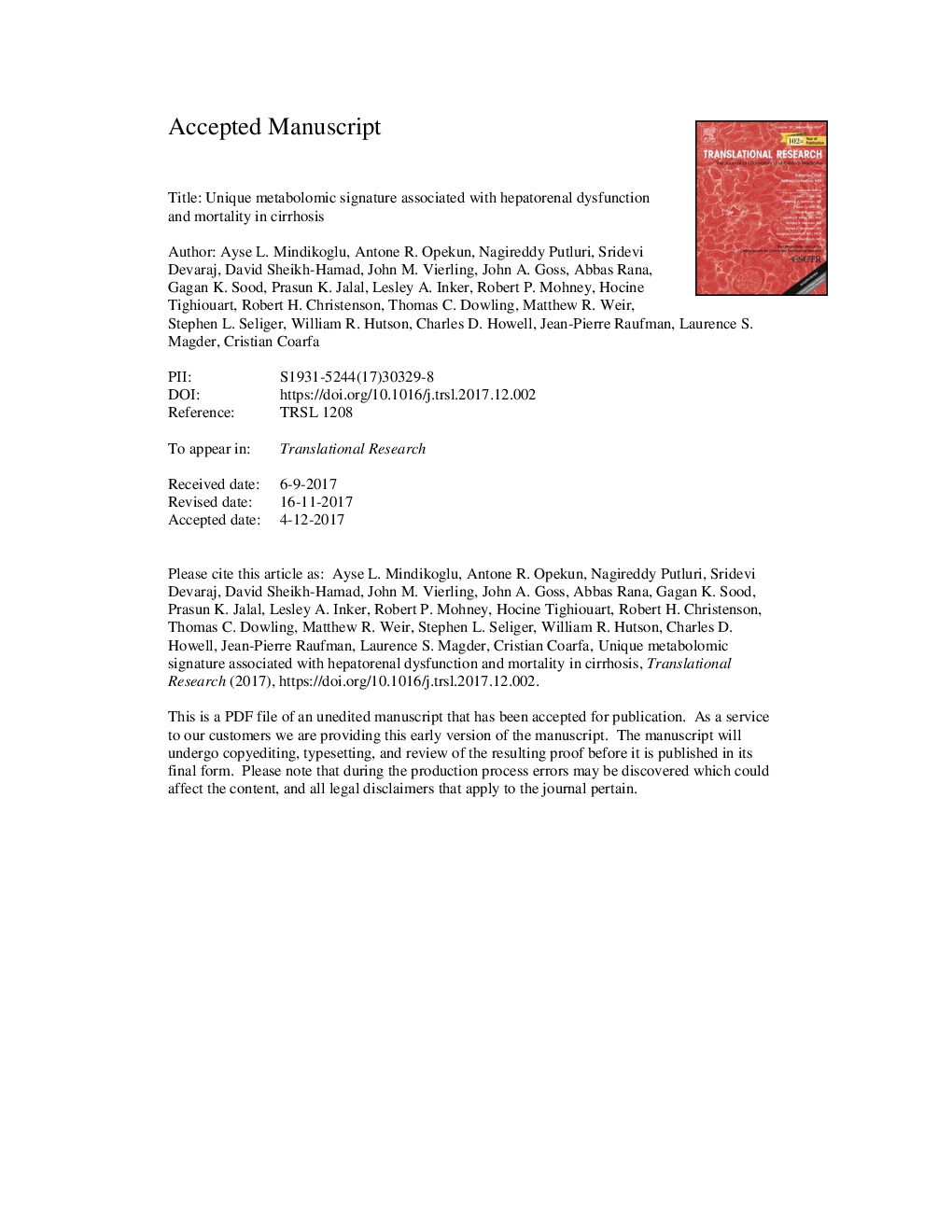| کد مقاله | کد نشریه | سال انتشار | مقاله انگلیسی | نسخه تمام متن |
|---|---|---|---|---|
| 8768957 | 1597915 | 2018 | 69 صفحه PDF | دانلود رایگان |
عنوان انگلیسی مقاله ISI
Unique metabolomic signature associated with hepatorenal dysfunction and mortality in cirrhosis
ترجمه فارسی عنوان
امضای متابولیکی منحصر به فرد در ارتباط با اختلال هپاترونن و مرگ و میر در سیروز
دانلود مقاله + سفارش ترجمه
دانلود مقاله ISI انگلیسی
رایگان برای ایرانیان
کلمات کلیدی
ESIAminoacylase 1ACY1AKIGFRFDRBHMTsDMAUPLCMS/MS - MS / MSAdenosine Triphosphate - آدنوزین تری فسفاتATP - آدنوزین تری فسفات یا ATPacute kidney injury - آسیب حاد کلیهgamma-aminobutyric acid - اسید گاما آمینو بوتیریکbetaine homocysteine methyltransferase - بتایین هوموسیستئین متیل ترانسفرازBUN - خوبsymmetric dimethylarginine - دی متیل آرژینین متقارنTandem mass spectrometry - طیف سنجی جرمی پشت سر هم یا متوالیMELD-Na - ملد-سدیمfalse discovery rate - میزان کشف کاذبGlomerular filtration rate - نرخ فیلتراسیون گلومرولیblood urea nitrogen - نیتروژن اوره خونHILIC - هیلیکcreatinine - کراتینینUltrahigh performance liquid chromatography - کروماتوگرافی مایع با عملکرد فوق العاده بالاhydrophilic interaction liquid chromatography - کروماتوگرافی مایع متقاطع هیدروفیلیGABA - گاباelectrospray ionization - یونیزاسیون الکترو اسپری
موضوعات مرتبط
علوم پزشکی و سلامت
پزشکی و دندانپزشکی
پزشکی و دندانپزشکی (عمومی)
چکیده انگلیسی
The application of nontargeted metabolomic profiling has recently become a powerful noninvasive tool to discover new clinical biomarkers. This study aimed to identify metabolic pathways that could be exploited for prognostic and therapeutic purposes in hepatorenal dysfunction in cirrhosis. One hundred three subjects with cirrhosis had glomerular filtration rate (GFR) measured using iothalamate plasma clearance, and were followed until death, transplantation, or the last encounter. Concomitantly, plasma metabolomic profiling was performed using ultrahigh performance liquid chromatography-tandem mass spectrometry to identify preliminary metabolomic biomarker candidates. Among the 1028 metabolites identified, 34 were significantly increased in subjects with high liver and kidney disease severity compared with those with low liver and kidney disease severity. The highest average fold-change (2.39) was for 4-acetamidobutanoate. Metabolite-based enriched pathways were significantly associated with the identified metabolomic signature (P values ranged from 2.07Eâ06 to 0.02919). Ascorbate and aldarate metabolism, methylation, and glucuronidation were among the most significant protein-based enriched pathways associated with this metabolomic signature (P values ranged from 1.09Eâ18 to 7.61Eâ05). Erythronate had the highest association with measured GFR (R-squareâ=â0.571, Pâ<0.0001). Erythronate (Râ=â0.594, Pâ<0.0001) and N6-carbamoylthreonyladenosine (Râ=â0.591, Pâ<0.0001) showed stronger associations with measured GFR compared with creatinine (Râ=â0.588, Pâ<0.0001) even after controlling for age, gender, and race. The 5 most significant metabolites that predicted mortality independent of kidney disease and demographics were S-adenosylhomocysteine (Pâ=â0.0003), glucuronate (Pâ=â0.0006), trans-aconitate (Pâ=â0.0018), 3-ureidopropionate (Pâ=â0.0021), and 3-(4-hydroxyphenyl)lactate (Pâ=â0.0047). A unique metabolomic signature associated with hepatorenal dysfunction in cirrhosis was identified for further investigations that provide potentially important mechanistic insights into cirrhosis-altered metabolism.
ناشر
Database: Elsevier - ScienceDirect (ساینس دایرکت)
Journal: Translational Research - Volume 195, May 2018, Pages 25-47
Journal: Translational Research - Volume 195, May 2018, Pages 25-47
نویسندگان
Ayse L. Mindikoglu, Antone R. Opekun, Nagireddy Putluri, Sridevi Devaraj, David Sheikh-Hamad, John M. Vierling, John A. Goss, Abbas Rana, Gagan K. Sood, Prasun K. Jalal, Lesley A. Inker, Robert P. Mohney, Hocine Tighiouart, Robert H. Christenson,
